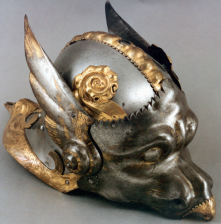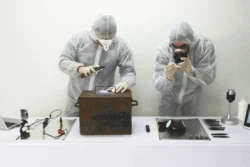
Press Release (ePRNews.com) - BRISTOL, England - Jul 31, 2017 (UTC) - In addition to being based on George RR Martin’s celebrated series of novels, the show draws inspiration for its look from across Europe and the Middle East.
10. Faith Militant maces
The Sparrows are a shadowy cabal of religious fanatics that take over King’s Landing in the fifth season of the show.
This 15th century Gothic mace made $3,500 at auction in 2015 – Image: Auctions Imperial
The armed faction of the group is known as the Faith Militant.
Wielding maces, they carry out the bidding of the High Sparrow. In Europe during the middle ages, such fanatics were fairly common – with adherents to different strains of Christianity duking it out on the regular.
While the mace has been around for centuries, it was favoured by the clergy as it allowed them to kill without spilling blood.
9. Ice
While Ned Stark carks it before the end of season 1, he casts a long shadow on the story that follows.
This 16th century Claymore was made in Germany – Image: Thomas Del Maar Ltd
As the gruff leader of the northern houses he arms himself with a suitably impressive Claymore nicknamed Ice.
Originating in Scotland in the 1400s, these enormous swords had to be wielded with both hands.
They were particularly popular with armoured ground troops who could sacrifice speed for power.
8. Stark shield
Round shields, like the ones carried by the Starks’ house guard, were not just designed to protect – they could also be used offensively.
This is an original Anglo-Saxon shield – Image: Wikimedia Commons
They were carried by armies across Europe from the Bronze Age right up until the advent of gunpowder.
7. Dothraki sword
While the Dothraki are clearly inspired by the Mongols, they differ from these deadly ancient warriors in a number of ways.
This sword belonged to a soldier in the army of Ramses II (circa 1303-1213 BC) – Image: Wikimedia Commons
Chiefly they favour spears and hooked swords, rather than the bow and arrow used by the Mongols.
The sword itself resembles a scythe and doesn’t have an analogue in Europe. We have to look instead to the Ancient Egyptians, who used a similar sword known as a Khopesh.
These vicious looking weapons evolved from axes and look like they could make a real mess of you. However, as they fell out of favour in around 1300 BC it’s unclear if they were effective on the battlefield.
6. Dragonglass
Dragonglass, also known as obsidian, is a rare material in the GoT universe that has the power to kill White Walkers – making it a key plot device.
The Clovis people were among the first inhabitants of North America – Image: Morphy’s Auctioneers
It’s also one of the few items in the show that exists in the real world. Obsidian is a glassy black stone formed by volcanic activity.
It was highly prized by prehistoric humans, as its extraordinary strength made it perfect for making knives and spear points.
This is a very famous example known as the Rutz Clovis point, discovered in a field outside Washington, DC in the 1950s.
5. Needle
Arya Stark is just a child (11 in the show, 9 in the books) when her father, Ned, gifts her Needle.
This elaborate small sword was made in 18th century Germany – Image: Czerny’s International Auction Service
This small, razor sharp sword has its analogues in a type known (rather unimaginatively) as a small sword.
This style of weapon originated in France and became very popular with upper class dandies. Over time it spread throughout Europe. It was often used as a duelling weapon.
4. Unsullied helmet
The Unsullied are the fearsome, virginal warriors that dragon botherer Daenerys Targaryen recruits on her path to world domination.
This helmet is known as the Corinthian type and originates from the 6th century BC – Image: Ancient Resource
Armed with spears and shields, they use similar tactics to real life ancient light infantry troops – including the enormously successful Greek hoplites.
Their helmets in the show resemble those worn by the Hoplites. The design evolved slowly over hundreds of years before taking this form.
3. Gendry’s helmet
Gendry, illegitimate son of Robert Baratheon, is a skilled armourer. When he’s forced to flee King’s Landing he brings with him an elaborate boar’s head helmet.
In real life such helmets weren’t much cop in battle, but they do exist as expressions of armourer’s skill.
This bizarre, monstrous figure is even more elaborate than the one seen in the show. It was made by German maker Desiderius Helmschmid (1513-1579) for Holy Roman Emperor Charles V.
2. Dragon Eggs
Sadly (or perhaps, thankfully) dragons aren’t real.
Few dinosaur eggs have survived in this condition – Image: Wikimedia Commons
But a few millions years ago Earth was home to the next best thing.
Dinosaurs were huge, scaly monstrosities. Some could even fly. In fact, the case has been made numerous times that dragons may in fact have been directly inspired by dinosaurs.
The closest we can get to the dragon’s eggs seen on the show are the fossilized dinosaur eggs found at archaeological sites around the world.
This example is on display at the Wrexham Museum in Wrexham, UK.
1. Lannister armour
The ultra-wealthy and devious Lannisters favour armour that resembles the types produced in ancient Rome and renaissance Italy.
Bartolomeo Campi was an extraordinarily talented armourer – Image: Wikimedia Commons
One armourer who bridges this gap is 16th century maker Bartolomeo Campi, whose striking creations could have been made for the show.
This black and gold number in particular gives off a definite Lannister vibe.
https://www.justcollecting.com/movie-memorabilia/the-real…
Source : JustCollectingJustCollecting
Wales



